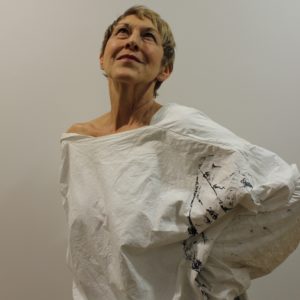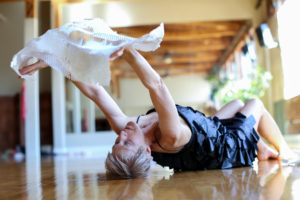Dancing While Aging
 Dancing while Aging
Dancing while Aging
“every atom belonging to me as good belongs to you.” Walt Whitman
Dance has formed my body and my life. I was born into a dancing family. My mother danced with Ruth St. Denis and Hanya Holm, a tradition that imprinted into my being from childhood. I toyed with the idea of a career in teaching and performing during the 1960’s, during the time of great sociopolitical change. For four decades, I carved out a trans-disciplinary career as a scholar of dance, science, and Somatics, rather than as a master of the practice.
Now, at 71, I am dancing more than I have in decades. I am, by most standards, an old woman (WHO). That I continue to move ‘artfully’ raises many questions about the relationship between dance and aging. One part of this act is to subvert the cultural stereotypes surrounding aging – that malign aging (in my case, female) bodies – ‘stereotypical representations of age(ing) bodies (Martin 2017:2). Dance touches us in many ways that go beyond the physical athleticism associated with youth. The culture is now rife with dance opportunities for the general public. These community classes benefit quality of life, regardless of age and condition (e.g., the dance for Parkinson’s movement). Dance has become the muse of neuroscientists, who attest to the physical, cognitive, emotional and social benefits, of dance. In one recent study, positive results from dance exceeded other forms of exercise in maintaining brain health in aging (e.g., Rehfeld, Lüders, Hökelmann, et al. 2018).
But I continue to dance for the same reasons as when I started half a century ago: to sharpen our mental and physical acumen in polishing a phrase, to partner with memory in telling our life’s story, to practice distributed creativity in community with other dancers, and simply, to recognize that we are a living continuum of becoming and change. We continue to be dancers while aging. If we could invite the neuroscientists to dance with us in the studio, it would be clear that we are not studying aging at all, but the unity of body, mind, and spirit, moving in homage to the human continuum.
I dance today for many of the same personal reasons that motivated me half a century ago: for the joy in the discipline of perfecting a phrase; to exercise thoughts, emotions and dreams; to explore and exploit movement abilities and qualities, to test my abilities in light of the best sense of sports(wo)manship, to ‘rehearse’ my life’s stories, to participate in ‘distributed creativity; (Kirsh et al, 2009), and simply, to emerge differently…’to become’ (LaMothe 2015). But what best describes aging while dancing? Am I a ‘seasoned’ dancer?…an ‘older,’ ‘mature’ or ‘veteran’ dancer?
Of course, the phenomenon of dancing beyond youth is not new. Liz Lerman broke ground in choreographing for Dancers of the Third Age, which appeared on the world stage in the early 1980’s. For all those who came before and after Liz, there’s no question that ageing dancers impact strongly and differently – on audience and dancer alike, whether as a community (Lerman 2013) or as solo artist (Lansley & Early 2011). Many aging artists shaped (and continue to shape) improvisation from the1960’s onwards (e.g., Anna Halprin, Deborah Hay, Steve Paxton, Lisa Nelson, Simon Forti). These pioneers developed exploratory practices which were able to ‘accommodate the changes of their age(ing) bodies’ (Martin 2017:20).
Two years ago, I joined a local community class assembled by a 73-year old dancer/choreographer from the Limon tradition of modern dance. Experienced and novice movers alike flocked to it. I thought I had found my bliss – an inroad into dancing that carried an appropriate mental and physical challenge of structured technique, without excessive demands for exertion — a place where the remnants of my training stroked my ego, while the lyrical aesthetic strummed by heart strings. But the real excitement for me lay in the joy of dancing with others, in a community of dancers where the playing field had been leveled enough to feel egalitarian. Within months of starting the class, I joined the non-profit offshoot of this class, a platform for dance performance. I never imagined that this (st)age, I would find myself performing before a paying audience without apology.
There are plenty of personal reasons that go against cultural stigmas of the inevitability of physical and mental decline, social marginalization and death. and the indulgence in a movement-based aesthetic, to name a few. But what explicit benefits am I deriving from dancing collectively? I found myself asking deeper questions which reflected cultural conceptions of ageing in the current Zeitgeist. I see that no dance is ‘neutral’ – freely exempt for the anxieties of the political moment. What began as a sheer indulgence into pleasure became a process of fielding and negotiating tacit sociocultural undercurrents with diplomacy and an open mind. Dance is, like evolution, not tame. I needed to develop and age-critical practice (Martin) It carries with it struggle. (a topic too broad to cover in this blog). ‘Dancing while aging’ is a window into a struggle in current Western society between the individual and the collective. This struggle continues to be waged across age. Now more than ever, I am emotionally more vulnerable as witness to, and participant in, a vulnerable world.
My one main question is: Are we practicing a form of intersubjectivity that raises all boats? Or are we acting out in various that are anti-ageist (trying to look and be younger than we are – more ‘beautiful and youthful’, competing with others in areas where we are physically stronger and mentally more quick?) Are we celebrating ‘diversity’ here, each of us aging uniquely? Are we involved in a practice that allows us (at any age/stage) to emerge from our habitus and become more expressive? Are we building a collaborative milieu in which we engage in peer-supportive practices? Are our ‘microstructures’ process oriented dynamic and open to change – leading to longer term enriching artistic practice – not just giving us a chance to appear on stage?
Am I guilty of acting out of the same social constructs that minimize and marginalize the individual and/or the collective? What thoughts and feelings erupt from within the phrase that challenge my human-ness?Am I acting in any way that is abusive to my fellow dancers – feeling/being competitive, criticizing them (openly or covertly), holding them to the same standards as youth,
MARTIN’s TOOLS (strategies) for developing a critical stance (116)
- Search for refinement and differentiation in perception and action (how does watching other bodies move make me fearful? Annoyed? Anxious? Disgusted?)
- Critique of one’s own presumptions and conventions – to subvert stereotypical representations of age(ing); to suspend dichotomist conceptions of age(ing), and to disrupt ageist cultural norms (121)
- Acceptance and activation of one’s possibilities here and now – with honesty, empathy, vulnerability
All human beings are unique, and each person’s aging trajectory is too. My rate of brain processing has slowed, and the amount of information I can process at any one time has diminished. I am honing somatic skills more carefully and differently than I did at an earlier age, when, for example, marking stood as a quick shorthand for learning phrases. Now, I pay more attention to somatic techniques while on the go – sharpening skills that balance active rest with physical repetition, using kinesthetic mnemonics to stimulate memory and enhance sense-ability, engaging mental imagery to spare my joints from excessive impact. I redefine risk as risk-without-recklessness. I realize that tripping over myself, nearly falling, arriving behind the beat, fumbling through changing levels – are ways of stimulating new pathways to movement novelty. I am stretching the boundaries of ‘normal’ movement and celebrating ‘difference’ rather than compensating.
My psychophysical shock absorbers are thinner, my fallibility, naked. I am, fundamentally, human, and in compassionate dialogue with self and others. Dance is this study of being human, the manifestation of bio-psycho-social complexity and uncertainty (Morin 1999:10). The call is to align myself with what ecologist Edgar Morin called a ‘critical planetary conscious and citizenship’ (Morin 1999:57), one that is deeply embodied, empathic and interdependent (Kampe and Batson, in press).
Dance has always been a means of practicing agency, autonomy and activism. But above all, dance is part of, what Dr. Martin Luther King, Jr. called, our “inescapable network of mutuality’
For this I dance: I am a human being who continues to dance for the (he)art of it – to translate and transmit an embodied legacy across generations, to continue to ask the questions that arise in the shared palette of hues that a moving collective brings.

- While the World Health Organization assigns ‘old age’ to those between the ages of 60-65 years old.
First published on the National Dance Education Organization website, Behind the Curtain blogposts.
https://www.ndeo.org/content.aspx?page_id=2507&club_id=893257&item_id=567
References on Request